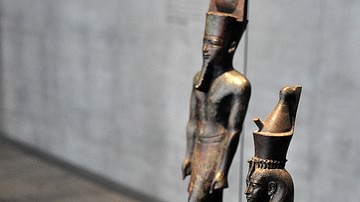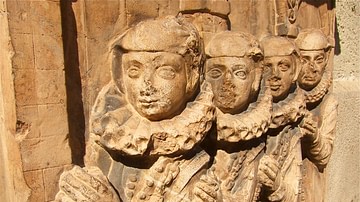Review

| Rating: | |
|---|---|
| Title: | Eleanor of Aquitaine, as It Was Said: Truth and Tales about the Medieval Queen |
| Author: | Professor Karen Sullivan |
| Audience: | University |
| Difficulty: | Hard |
| Publisher: | University of Chicago Press |
| Published: | 2023 |
| Pages: | 304 |
Sullivan's "Eleanor of Aquitaine" delves into the complex life of the medieval queen who ruled both France and England. Sullivan critically examines centuries-old accounts, both factual and legendary, to explore Eleanor’s political influence, romantic affairs, and cultural impact. This meticulously researched work is ideal for scholars of medieval history, offering a nuanced portrayal of Eleanor's legacy, though its dense and detailed style may be challenging for general audiences.
The presence of women in positions of power has consistently captivated individuals, and the reign of Eleanor of Aquitaine is a prime example of this phenomenon. Born in 1122, she was a prominent medieval queen who held power in both France and England. Irma Brandeis Professor of Romance Literature and Culture at Bard University, Karen Sullivan, provides meticulously researched accounts of Eleanor's life in her latest work, Eleanor of Aquitaine, as It Was Said: Truth and Tales of the Medieval Queen.
The author details Eleanor’s life from her birth around 1122 to her death in 1204. The work itself is a clear and impressive display of dedication Karen Sullivan offers on the topic of the Duchess of Aquitaine and all things related to the marvel of medieval studies.
Accounts of Eleanor’s life have been extensively discussed and disputed for centuries. Today, it remains a subject of scholarly controversy. Sullivan proves that Eleanor of Aquitaine's enduring historical legacy is attributed to her wealth, influence, alleged romantic affairs, and even her collaborated plot to overthrow her husband, King Henry II. Medieval authors warned readers by using the term "it was said" to qualify their accounts of Eleanor. This phrase indicated that they were merely recounting stories that were already in existence, and Sullivan's book uses this point as the springboard for its discussions.
Numerous highlights describe Eleanor’s significant impact on the regions she ruled. Her influence extended beyond her political roles, affecting the cultural and intellectual life of the time. The book explores her patronage of the arts and her role in developing chivalric culture. Sullivan scrutinizes topics of modern media, such as movies depicting Queen Eleanor with the same attention as the manuscripts of 12th-century histories, which may come off as dense to some readers.
Eleanor’s life as Duchess of Aquitaine, Queen of France, Queen of England, and mother of kings was complex. Sullivan examines these details thoughtfully without oversimplification when summarizing the complicated minutiae of Eleanor’s experiences, as they were said. The coverage of Eleanor’s life and relationships in the text, as well as descriptions of her time imprisoned and time spent at the Abbey of Fontevraud, are truly fascinating.
According to Sullivan, although the tales of Eleanor from the Middle Ages possess an imaginative quality, they offer insights into the societal norms for women in 12th-century France. The primary subject of this book is the examination of these truths by Sullivan to the extent that they can be comprehended from an outside perspective.
This title will not disappoint those who are seeking a deep dive into the various medieval clerical texts and manuscripts that mention Eleanor of Aquitaine. Sullivan, being a true expert on the topic, gives readers a book based on critically analyzed historical sources. The work draws on a range of sources to offer a nuanced portrait of Eleanor. Therefore, the book is not a simple read and might not suit younger readers, such as those in secondary schools. Sullivan's writing incorporates elaborate historical details that she examines from various viewpoints and intellectual debates. The material itself is recommended for research purposes versus reading for pleasure.
Overall, Karen Sullivan’s biography aims to present Eleanor of Aquitaine not just as a historical figure but as a complex individual with considerable influence no matter the source. This book should be considered a well-regarded resource written by an expert for those interested in medieval studies and the role of women in historical politics.
Cite This Work
APA Style
Anne, K. (2024, October 09). Eleanor of Aquitaine, as It Was Said: Truth and Tales about the Medieval Queen. World History Encyclopedia. Retrieved from https://www.worldhistory.org/review/477/eleanor-of-aquitaine-as-it-was-said-truth-and-tale/
Chicago Style
Anne, Kimberly. "Eleanor of Aquitaine, as It Was Said: Truth and Tales about the Medieval Queen." World History Encyclopedia. Last modified October 09, 2024. https://www.worldhistory.org/review/477/eleanor-of-aquitaine-as-it-was-said-truth-and-tale/.
MLA Style
Anne, Kimberly. "Eleanor of Aquitaine, as It Was Said: Truth and Tales about the Medieval Queen." World History Encyclopedia. World History Encyclopedia, 09 Oct 2024, https://www.worldhistory.org/review/477/eleanor-of-aquitaine-as-it-was-said-truth-and-tale/. Web. 22 Apr 2025.


